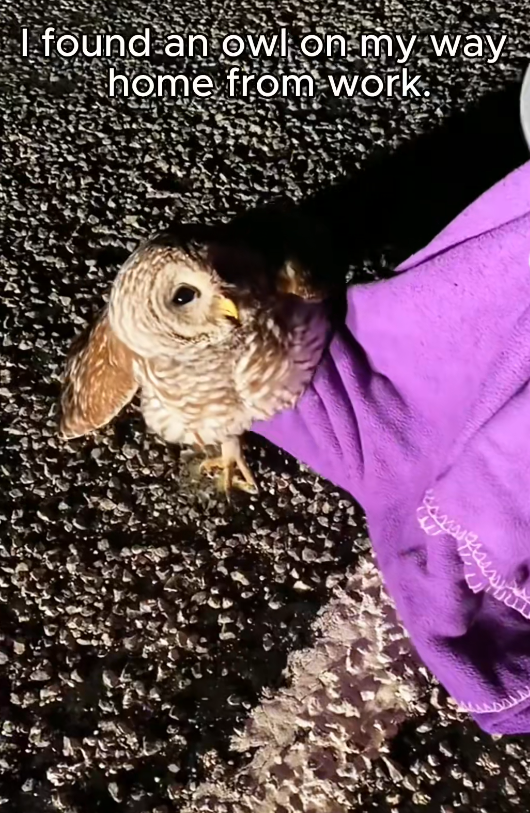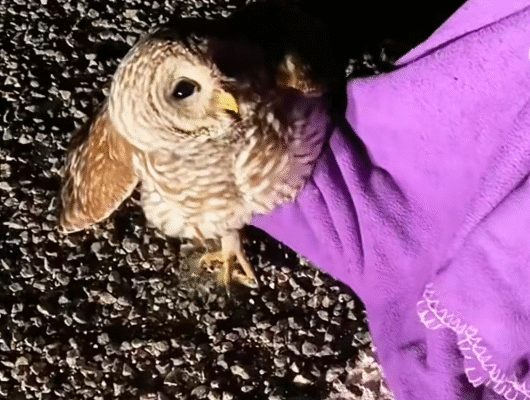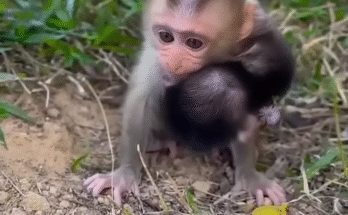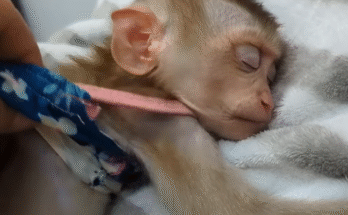It was an ordinary Tuesday evening, the kind that drags on with back-to-back meetings and emails that never seem to end. I was exhausted, the kind of tired that settles deep in your bones. I packed my bag, waved goodbye to the few coworkers still lingering at their desks, and stepped out into the fading sunlight. The sky had just begun to turn a soft amber, the city humming its usual symphony of honking cars and chatter. I was ready to go home, kick off my shoes, and crash into the couch.
I took my usual shortcut—down a quiet residential street lined with tall trees and neat little houses. As I walked, I noticed something unusual up ahead on the sidewalk. At first, I thought it was a bag or a piece of trash someone had dropped. But as I got closer, I saw it move. My heart skipped a beat.
Lying there, feathers slightly ruffled and eyes blinking slowly, was a small owl. An owl. On the sidewalk. In the middle of the city.
I stopped in my tracks, unsure of what to do. The owl didn’t seem frightened by me, nor did it try to fly away. It just sat there, looking up with wide, amber eyes that sparkled even in the dim light. I knelt down slowly, careful not to startle it.
“Hey there, little one,” I whispered, as if the owl might understand.
Its feathers were a mixture of soft browns and grays, with a distinct heart-shaped face. It looked young, maybe a juvenile barn owl. One of its wings was slightly raised, and I noticed it trembled when it tried to tuck it back in. That’s when I realized—something was wrong.

My first instinct was to call animal control, but I didn’t want to leave the owl alone in case a dog or car came by. I gently pulled off my jacket and draped it around the bird. To my surprise, it didn’t resist. It was too weak or too hurt to care. I slowly gathered it into my arms, holding it close as if cradling a sleeping child. It was so light, yet so full of life.
I didn’t know much about owls, but I knew I couldn’t leave it there. I carried it the rest of the way home, keeping my movements steady and gentle. The owl didn’t make a sound. Its head tilted slightly, as if trying to understand who I was and where we were going.
Once home, I placed it in a cardboard box lined with an old towel and covered it loosely to keep it warm and calm. I began searching online for local wildlife rescue centers. Thankfully, there was one about twenty minutes away, and even better—they had an emergency number.
I called and spoke with a kind woman named Maria. After I described the owl and its condition, she told me I’d done the right thing. “Keep it warm, quiet, and away from pets or people,” she said. “We’ll have someone there to pick it up within the hour.”
I sat near the box, sipping tea and watching the owl breathe slowly. There was something magical about having such a mysterious, nocturnal creature in my home. Owls are symbols of wisdom and mystery, often silent witnesses to the night. I never imagined one would end up in my living room.
True to her word, Maria arrived about forty-five minutes later. She wore a uniform with the rescue’s logo and carried a soft-sided animal carrier. She moved with calm expertise, gently transferring the owl into the carrier and checking its wing.
“It looks like a soft tissue injury, maybe from a fall or getting clipped by a car,” she said. “But it’s alert and its eyes look good. That’s a great sign.”
I felt a rush of relief. “Will it be okay?”
“We’ll do everything we can,” she said, giving me a reassuring smile. “Thank you for not leaving it. Most people would’ve just walked by.”
After she left, the house felt unusually quiet. I kept thinking about that moment on the sidewalk—how easily I could’ve missed it, how the tiniest decision to stop and help had made such a difference. The rest of the evening passed slowly. I kept checking my phone for updates, even though I knew none would come right away.
The next morning, I called the rescue center. They told me the owl was stable and resting. They confirmed it was a young barn owl, likely just fledged, and had probably gotten disoriented and injured during one of its first solo flights. It would need a few weeks of rehabilitation before it could be released back into the wild.
That news filled me with an unexpected joy. The owl had a chance. It wasn’t just about rescuing a bird—it was about giving something small and vulnerable a second shot at life.
Over the next few weeks, I followed the rescue center’s social media page. They occasionally posted updates and photos of their patients. One day, I saw a post that made my heart leap. There, perched proudly on a wooden beam in an outdoor enclosure, was a familiar young barn owl. “This brave little one is healing well and will soon be ready for release,” the caption read.
I saved the photo and smiled every time I looked at it. A week later, they posted a short video showing the owl being released at dusk, wings strong and sure as it soared into the sky. The caption simply said: “Fly free, little hunter.”
Since then, I’ve never looked at my walk home the same way. I pay more attention. I listen more carefully. And I remind myself that even on the most ordinary days, something extraordinary can happen when you least expect it.
That owl didn’t just find me—I think, in some way, I needed it just as much as it needed me. Life has a way of placing us in the right moment, if only we choose to notice.
And now, every time I hear an owl hoot in the distance, I like to imagine it’s my owl, living its wild life, free and fearless under the stars.



